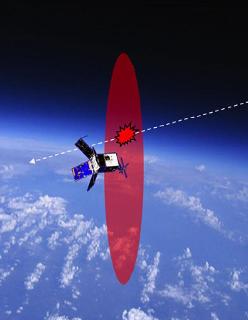May 22 2015
The U.S. Naval Research Laboratory (NRL), Geospace Science and Technology Branch, has received a U.S. patent for the Optical Orbital Debris Spotter, a compact, low power, low cost, local space debris detection concept that can be integrated into larger satellite designs, or flown independently on-board nano-satellite platforms.
 The Optical Orbital Debris Spotter is capable
The Optical Orbital Debris Spotter is capable
The number of man-made debris objects orbiting the Earth continues to increase at an alarming rate -- with objects smaller than one centimeter (cm) exceeding 100 million. The effects of collisions occurring at orbital velocities, approaching several kilometers per second, can range from minor to catastrophic. In Low Earth Orbit (LEO), where many space-based assets reside, small debris objects are of concern not only due to their abundance, but because they are often difficult to track or even detect on a routine basis.
The fundamental concept for the orbital debris detection sensor is to create a continuous light sheet by using a collimated light source, such as a low power laser, and a conic mirror. The key idea of this concept is to form a permanently illuminated light sheet rather than scanning a beam. This way, all particles intersecting the beam will scatter the light from the source, independent of the time of intersection with the plane of the light sheet.
"When the flight path of an orbital debris object intersects the light sheet, the object will scatter the light, and a portion of that scattered light can be detected by a wide angle camera," said Dr. Christoph Englert, research physicist at NRL. "The knowledge of the light sheet geometry and the angles of the scattering event with respect to the camera, derived from the signal location on the sensor, allow the determination of the intersection point, and possibly even size, and shape information about the debris particle."
Many debris studies are performed using damaged satellite surfaces that are brought back to the Earth after months or years in orbit. This newly patented concept can provide, at a minimum, a similar or even improved data set in close to real-time without the necessity of returning satellites back to Earth. Small, stand-alone sensor systems, such as the optical orbital debris spotter, could also be deployed within a debris cloud to provide in-situ measurements of debris density, distribution and evolution.
"Using a dedicated nano-satellite, or CubeSat, the system could also be used for gathering of more comprehensive debris field data," Englert said. "Losing the satellite at some point during the mission by a fatal collision could be considered a justifiable risk in comparison to the odds of getting unprecedented data sets for debris field characterization and modeling."
The sensor concept, weighing approximately two kilograms and measuring approximately 10cm x 10cm x 20cm, depending on specific implementation, could gather valuable input for modeling and prediction software that is starved for information on small debris pieces. These data sets could then be incorporated into global space tracking tools such as the Space Surveillance Network (SSN), NASA's Orbital Debris Engineering Model (ORDEM), and the European Space Agency's Optical Ground Station.